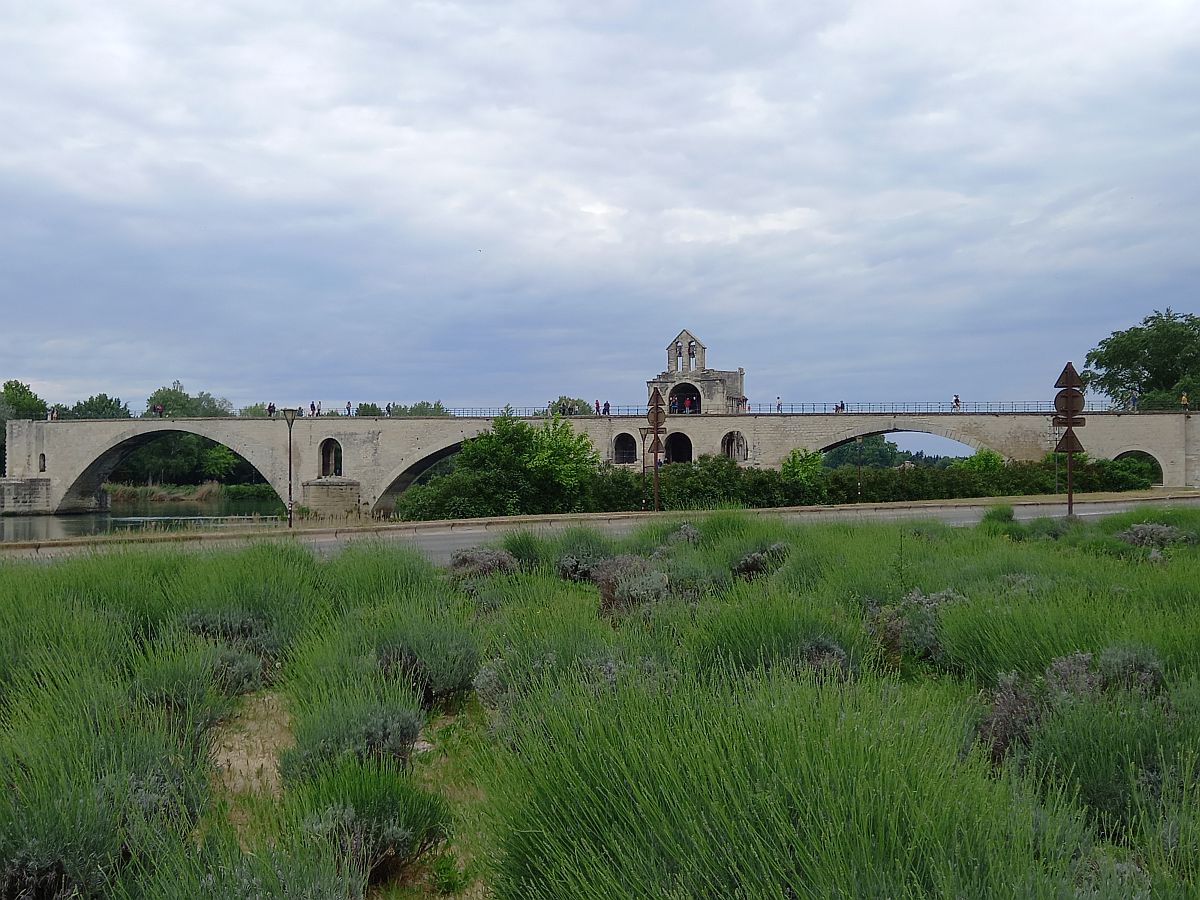
| Go to Allan's Page | Our Home Page | Holidays Home Page | British Canals Page | Go to Deb's Page |
| FlickR album of these photos | Part 2: The River Seine |
Sur le Pont d'Avignon,
L'on y danse, l'on y danse
Sur le Pont d'Avignon,
L'on y danse tous en rond
Almost everybody knows this old French children's song, which translates as:
On the bridge in Avignon
They dance there, they dance there
On the bridge in Avignon
They all dance there in a round
Except that everybody is singing the wrong words. The bridge was far too narrow for people to have danced in a round without falling off; they actually danced in circles on the shore underneath the first arch, and the original words were 'Sous le Pont d'Avignon' (UNDER the bridge ....) but the first person to write them down mis-heard them and the wrong version has been famous ever since.
But I am getting ahead of myself; rewind to 3am when the taxi collected us to go for a very early flight from Heathrow to Marseille, for a French river-cruising holiday that we had booked with Viking Cruises. We had a good trip, and stepped into the warmth of the South of France with high expectations of a hot sun-filled holiday; how wrong we were!
A minibus took us to Avignon where we joined the ship, Viking Buri, in time for an excellent lunch and a short afternoon walk around the town including a stiff climb up to the Palace Gardens to admire the view as well as a brief wander around the market to buy a couple of souvenirs. That evening we had an excellent meal, and met many of our fellow passengers (most of whom were American) before retiring for an early night after such a long day.
The ship departed that night, heading back towards Marseille as far as Arles, whose main claim to fame is that it was home to Vincent van Gogh for the last part of his life - a period during which he went mad, cut off his ear, spent time in an asylum and a hospital, and painted some of his most memorable works of art. We had an enjoyable visit to Arles, particularly admiring the way they had placed easels precisely at places where van Gogh had painted some of his best works; these easels each held a copy of the painting in question so that you could see the scene as van Gogh had seen it and compare it with the same scene as it is today.
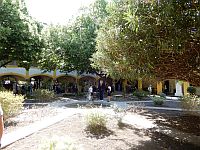 |
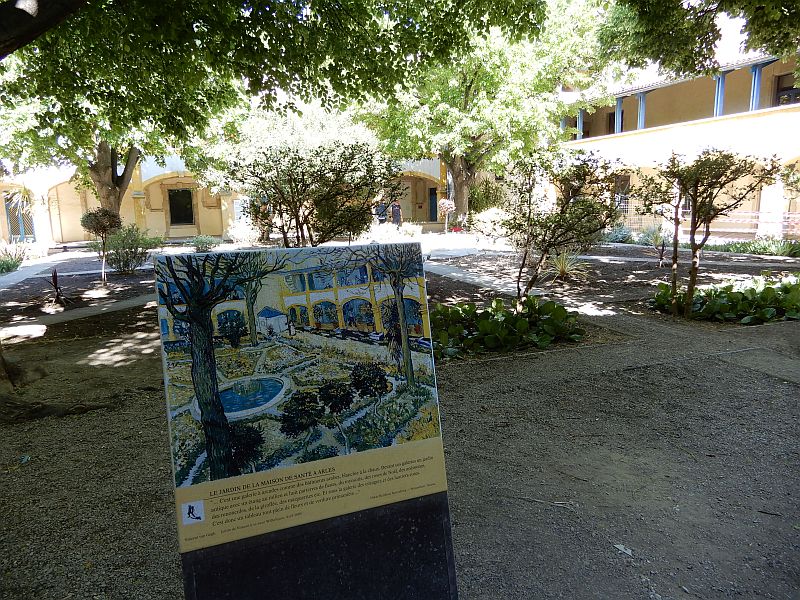 |
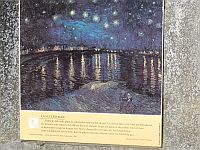 |
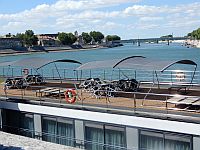 |
The hospital where van Gogh stayed ... |
... and how he painted its picture |
Where he painted 'Starry Night' ... |
is not so easy to recognise today |
Arles had also the most amazing Roman amphitheatre. With a seating capacity of 20,000 people, it is still in use to this day, mainly for theatrical performances but also for bullfight. Their preference is now for events where the bulls are unharmed; instead the brave (or foolhardy) matadors simply chase after the bulls in an attempt to snatch ribbons from their horns. Their love for the theatre is also demonstrated by the many beautiful paintings of theatrical scenes on the walls of the buildings, especially in any bricked-up windows.
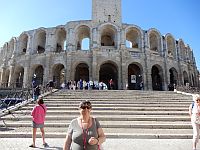 |
 |
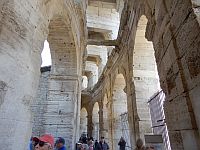 |
Outside the amphitheatre at Arles |
The interior of the amphitheatre |
The exit area, known as the Vomitorium |
The weather in Arles gave us a great surprise, for there was a strong Northerly gale which made it bitterly cold. This, we discovered, was the Mistral wind which normally blows for just a couple of days each month; for us it blew nearly every day and made us wish we'd brought more warm clothing.
The ship turned around and took us back to Avignon that night. We opted for a comprehensive walking tour of Avignon, discovering more about the famous bridge (of which just 2 of the original 22 arches remain, the others having been washed away in a flood) and the ancient city walls which remain intact to serve as a flood defence. We climbed many steps to admire the interior of the magnificent Pope's palace. though these were nowhere near as strenuous as we had been led to expect. I couldn't help wondering how the 14th century Catholic Church could in all conscience show such a flamboyant display of wealth.
The afternoon gave us one of the tours we had been most looking forward to: wine tasting at the Chateauneuf du Pape. It was indeed a superb visit to this famous winery, with an excellent lecture on the art of wine-tasting accompanied, of course, by the opportunity to sample some of their famous wines. We would have loved to buy a few bottles to take home with us, as the prices were very reasonable, but we would not have been able to carry them on the plane ourselves and would not have risked putting them in our suitcases (having them sent to us would have incurred ridiculously high carriage costs). That night at dinner we had wines from the same region, made with the same variety of grape, but which were from a lesser chateau and were therefore much cheaper (or in our case free, as we had purchased the ship's drinks package).
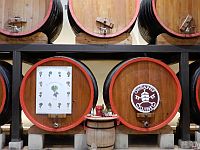 |
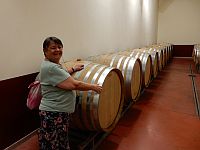 |
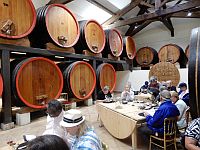 |
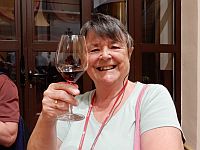 |
The famous winery of Chateauneuf-du-Pape |
Debbie has found a few barrels |
There are many more barrels in the tasting room |
Debbie likes the taste of Chateauneuf-du-Pape! |
The evening's entertainment was great fun, being a game of 'Liars Club which was an American panel game show during the 1970's and 1980's, broadly similar to our programme of 'Call my Bluff'. We were very familiar with one of the words, Gongoozler, which is much used on the English canals to describe somebody who just sits and watches the boats as they go past.
The next day we were at the charming medieval village of Viviers. We walked up the steep pathways to the Upper Town, reputedly made to be too narrow to draw a sword properly, from where we looked down on the ancient rooftops. At least the Mistral wind kept us cool for the climb! Returning back to the pretty Lower Town, we walked along an avenue of plane trees which was reputedly one of thousands that Napoleon planted to provide shade for his troops while marching. We were intrigued by the way that many trees had huge holes in their trunks; our guide explained that these had been caused by wood-eating bugs which had been inadvertently brought from America with a shipment of other plants - they had decided that they preferred to eat the plane trees but fortunately died out before doing any more serious damage.
The afternoon consisted of a leisurely cruise up-river, with a nautical lecture from the ship's captain, arriving that night at Tournant where the following day's activities included a steam-train ride up the little valley. The engine had two sets of driving wheels (to get the necessary traction for the steep gradient) that could pivot independently to get around the many twists and turns of the narrow-gauge track had many tight turns. We were warned to choose a carriage near the rear of the train if we wanted to avoid getting smutty! The scenery was fantastic, and we were also fascinated to watch the engine being turned around by hand before the ride back down to the lower station.
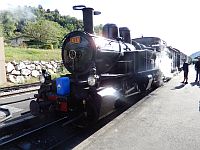 |
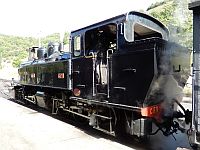 |
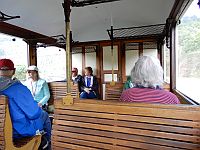 |
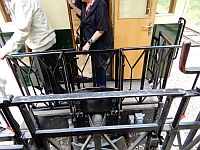 |
The steam engine was a most unusual design with two sets of 6 driving wheels, of narrow gauge and pivoting independently to get around the tight bends. |
The interior of our carriage |
The observation platforms between the carriages |
|
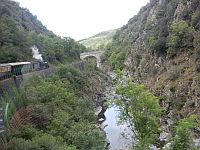 |
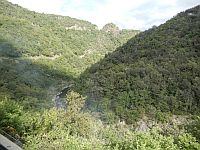 |
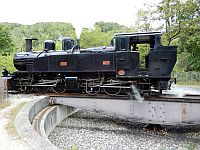 |
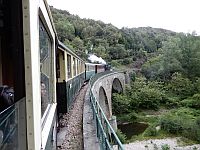 |
High above the river we climbed the narrow, twisting valley |
The scenery was simply magnificent |
The engine was turned around by hand PLAY VIDEO |
We made our way back down the valley to the lower station |
Meanwhile the ship had travelled further up-river to Vienne, so a coach was waiting to take us there. This little town also has an amphitheatre and several other Roman buildings including the well preserved Temple of Augustus and Livia which had survived from decay by being in constant use ever since the 1st century. There were many other beautiful buildings in the town, including the Town Hall and the Cathedral.
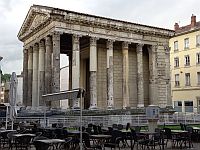 |
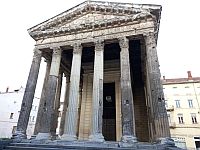 |
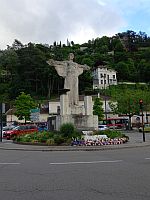 |
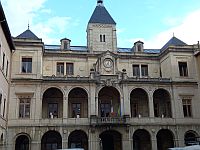 |
Vienne's 1st century Temple of Augustus and Lima |
A rather fine statue on a roundabout |
The magnificent town hall |
|
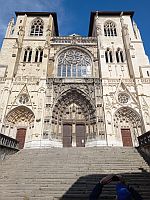 |
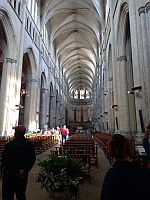 |
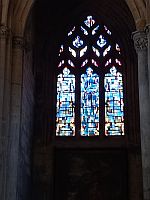 |
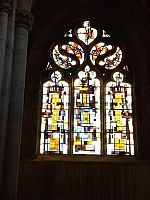 |
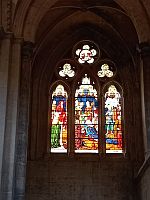 |
The facade of Vienne Cathedral is very impressive, The interior is huge and although fairly plain it has a large number of very beautiful stained glass windows |
||||
Once again we spent a wonderful evening in the ship's lounge, where the ship's entertainer, a talented singer and great pianist, played a wide variety of songs including a number of requests. Finally the next day we arrived at the ship's destination, the city of Lyon. After a coach-trip up the hill to the Basilica, where the Mistral was again extremely cold for us, we had a fascinating tour of the city.
The city had become extremely prosperous through the silk trade which is now of course much depleted. As we wandered around the town we were lucky enough to find a tiny silk shop with its original looms on display, from where Debbie bought a beautiful locally-made silk scarf.
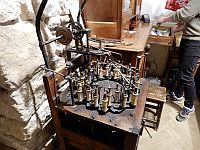 |
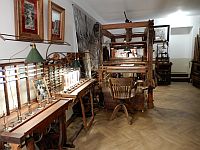 |
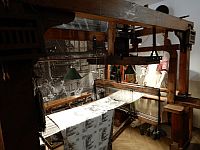 |
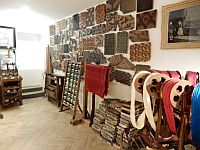 |
A table of silks ready for weaving |
The original Jacquard loom... |
... which works to a pattern of punched-cards |
A selection of silken products |
We were also shown through one of the tiny 'traboules' which are like indoor alleyways; multiple passageways hidden anonymously behind front doors which are indistinguishable from those of the other houses in the terrace but leading via indoor courtyards to several separate dwellings and leading through to the next street. Originally built apparently for use by medieval merchants, they served a useful purpose during World War II as hiding places from the Nazis.
We had not realised that during the early part of the war Lyon was an important centre near the boundary between Occupied France (to the North) and Unoccupied France (to the South). This was all explained to us at a fascinating lecture on the ship that afternoon; many of the American passengers seemed genuinely surprised to learn that the war actually started back in 1939! During the lecture, just as the speaker was talking about bombing raids, there was a sudden flash of light followed immediately by a deafening crash; of course it was just a thunderstorm, but several of the audience looked ready to dive for cover.
Of course we couldn't leave the Rhone/Saone valley area without paying a visit to the Beaujolais wine district and sampling some of their products. A coach took us through miles and miles of vineyards, before we arrived at a beautiful old chateau. Apparently it had only ever been owned by two families; the original owner had been a keen gambler and had lost it to a member of the current family in the 19th century. The visit was fascinating as in both the grounds and the cellars there were groups of people rehearsing for their upcoming festival. We had a very enjoyable time, and tasted 4 of their wines: Beaujolais, Beaujolais Villages, Special Cru, and Cru Reserve - of these, although it was not the most expensive, we liked the Beaujolais Villages best..
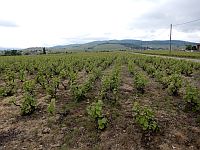 |
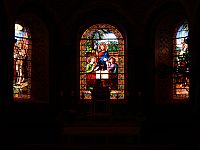 |
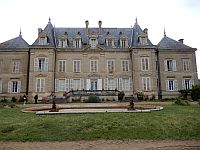 |
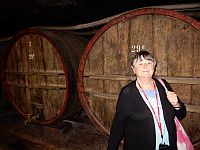 |
We drove past miles and miles of Beaujolais vineyards |
We visited a small village church with beautiful windows |
The chateau was very impressive ... |
... as were the barrels of wine in the cellars |
That evening there was a Farewell gathering, so we could say goodbye to the ship's crew who had all been excellent, and then it was time to pack our suitcases which would have to be left outside our cabin at 5.30 am. They were taken by road to Paris while we would travel later by train/ The travel arrangements were absolutely excellent, including good seats on the TGV which sped us to Paris at 180mph and arrived on time to the exact minute, and the Viking rep met us at the station and gave us a brief coach tour of the city (very slowly amongst the traffic-jams) on the way to meet our luggage again at the gangway of our next ship, the Viking Fjorgyn which was moored about three-quarters of a mile from the Eiffel Tower. Our week on the Seine was about to begin ...
| FlickR album of these photos | Part 2: The River Seine | |||
| Go to Allan's Page | Our Home Page | Holidays Home Page | British Canals Page | Go to Deb's Page |
All pictures on this site are © Allan Jones unless otherwise stated